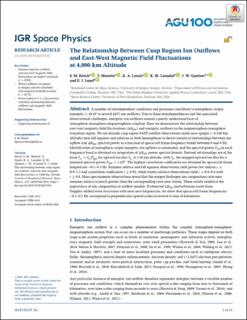The Relationship Between Cusp Region Ion Outflows and East-West Magnetic Field Fluctuations at 4,000-km Altitude
Hatch, Spencer Mark; Moretto, Therese; Lynch, Kristina A.; Laundal, Karl Magnus; Gjerloev, J.; Lund, Eric
Journal article, Peer reviewed
Published version

Åpne
Permanent lenke
https://hdl.handle.net/11250/2740087Utgivelsesdato
2020Metadata
Vis full innførselSamlinger
Originalversjon
Journal of Geophysical Research: Space Physics. 2020, 125 (3), e2019JA027454. 10.1029/2019JA027454Sammendrag
A number of interdependent conditions and processes contribute to ionospheric-origin energetic ( ∼ 10 eV to several keV) ion outflows. Due to these interdependences and the associated observational challenges, energetic ion outflows remain a poorly understood facet of atmosphere-ionosphere-magnetosphere coupling. Here we demonstrate the relationship between east-west magnetic field fluctuations ( ΔB EW ) and energetic outflows in the magnetosphere-ionosphere transition region. We use dayside cusp region FAST satellite observations made near apogee ( ∼ 4,180-km altitude) near fall equinox and solstices in both hemispheres to derive statistical relationships between ion upflow and ΔB EW spectral power as a function of spacecraft frame frequency bands between 0 and 4 Hz. Identification of ionospheric-origin energetic ion upflows is automated, and the spectral power P EW in each frequency band is obtained via integration of ΔB EW power spectral density. Derived relationships are of the γ form J ||,i = J 0,i P EW for upward ion flux J ||,i at 130-km altitude, with J 0,i the mapped upward ion flux for a nominal spectral power P EW = 1 nT 2 . The highest correlation coefficients are obtained for spacecraft frame frequencies ∼ 0.1–0.5 Hz. Summer solstice and fall equinox observations yield power law indices γ ≃ 0.9–1.3 and correlation coefficients r ≥ 0.92, while winter solstice observations yield γ ≃ 0.4–0.8 with r ≳ 0.8. Mass spectrometer observations reveal that the oxygen/hydrogen ion composition ratio near summer solstice is much greater than the corresponding ratio near winter. These results reinforce the importance of ion composition in outflow models. If observed ΔB EW perturbations result from Doppler-shifted wave structures with near-zero frequencies, we show that spacecraft frame frequencies ∼ 0.1–0.5 Hz correspond to perpendicular spatial scales of several to tens of kilometers.
